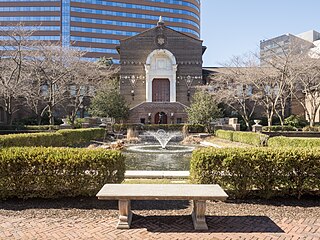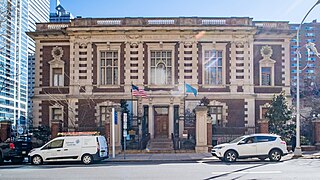Related Research Articles
Milford Howell Wolpoff is a paleoanthropologist and professor of anthropology at the University of Michigan and its museum of Anthropology. He is the leading proponent of the multiregional evolution hypothesis that explains the evolution of Homo sapiens as a consequence of evolutionary processes and gene flow across continents within a single species. Wolpoff authored the widely used textbook Paleoanthropology,and co-authored Race and Human Evolution:A Fatal Attraction,which reviews the scientific evidence and conflicting theories about the interpretation of human evolution,and biological anthropology's relationship to views about race.

MOVE,originally the Christian Movement for Life,is a communal organization that advocates for nature laws and natural living,founded in 1972 in Philadelphia,Pennsylvania,United States,by John Africa. The name,styled in all capital letters,is not an acronym. MOVE lived in a communal setting in West Philadelphia,abiding by philosophies of anarcho-primitivism. The group combined revolutionary ideology,similar to that of the Black Panthers,with work for animal rights.

An anthropologist is a person engaged in the practice of anthropology. Anthropology is the study of aspects of humans within past and present societies. Social anthropology,cultural anthropology and philosophical anthropology study the norms,values,and general behavior of societies. Linguistic anthropology studies how language affects social life,while economic anthropology studies human economic behavior. Biological (physical),forensic and medical anthropology study the biological development of humans,the application of biological anthropology in a legal setting and the study of diseases and their impacts on humans over time,respectively.

Forensic anthropology is the application of the anatomical science of anthropology and its various subfields,including forensic archaeology and forensic taphonomy,in a legal setting. A forensic anthropologist can assist in the identification of deceased individuals whose remains are decomposed,burned,mutilated or otherwise unrecognizable,as might happen in a plane crash. Forensic anthropologists are also instrumental in the investigation and documentation of genocide and mass graves. Along with forensic pathologists,forensic dentists,and homicide investigators,forensic anthropologists commonly testify in court as expert witnesses. Using physical markers present on a skeleton,a forensic anthropologist can potentially determine a person's age,sex,stature,and race. In addition to identifying physical characteristics of the individual,forensic anthropologists can use skeletal abnormalities to potentially determine cause of death,past trauma such as broken bones or medical procedures,as well as diseases such as bone cancer.

Penn Museum,formally known as The University of Pennsylvania Museum of Archaeology and Anthropology,is an archaeology and anthropology museum at the University of Pennsylvania. It is located on Penn's campus in the University City neighborhood of Philadelphia,at the intersection of 33rd and South Streets. It also is close enough for Drexel University students to walk or take SEPTA transportation services. Housing over 1.3 million artifacts,the museum features one of the most comprehensive collections of Middle and Near-Eastern art in the world.
A body farm is a research facility where decomposition of humans and animals can be studied in a variety of settings. The initial facility was conceived by anthropologist William M. Bass in 1981 at the University of Tennessee in Knoxville,Tennessee,where Bass was interested in studying the decomposition of a human corpse from the time of death to the time of decay. The aim was to gain a better understanding of the decomposition process,permitting the development of techniques for extracting information such as the timing and circumstances of death from human remains. Body farm research is of particular interest in forensic anthropology and related disciplines,and has applications in the fields of law enforcement and forensic science. By placing the bodies outside to face the elements,researchers are able to get a better understanding of the decomposition process.

Dr. Kathleen Joan Reichs (PhD) is an American crime writer,forensic anthropologist and academic. She is a professor emerita of anthropology at the University of North Carolina at Charlotte. She is well known for inspiring the television series Bones.

The Mütter Museum is a medical history and science museum located in the Center City area of Philadelphia,Pennsylvania. It contains a collection of anatomical and pathological specimens,wax models,and antique medical equipment. The museum is part of The College of Physicians of Philadelphia. The original purpose of the museum,founded with a gift from Dr. Thomas Dent Mütter on December 11,1858,was for the education of medical professionals,medical students,and invited guests of College Fellows,and did not become open to non-Fellows until the mid-1970s. The College of Physicians of Philadelphia is itself not a teaching organization,but rather a member organization or "scientific body dedicated to the advancement of science and medicine".

Samuel George Morton was an American physician,natural scientist,and writer. As one of the early figures of scientific racism,he argued against monogenism,the single creation story of the Bible,instead supporting polygenism,a theory of multiple racial creations.

Jane Ellen Buikstra is an American anthropologist and bioarchaeologist. Her 1977 article on the biological dimensions of archaeology coined and defined the field of bioarchaeology in the US as the application of biological anthropological methods to the study of archaeological problems. Throughout her career,she has authored over 20 books and 150 articles. Buikstra's current research focuses on an analysis of the Phaleron cemetery near Athens,Greece.

Susan Margaret Black,Baroness Black of Strome,is a Scottish forensic anthropologist,anatomist and academic. She was the Pro Vice-Chancellor for Engagement at Lancaster University and is past President of the Royal Anthropological Institute of Great Britain and Ireland. From 2003 to 2018 she was Professor of Anatomy and Forensic Anthropology at the University of Dundee. She is President of St John's College,Oxford.

Douglas W. Owsley is an American anthropologist who is head of Physical Anthropology at the Smithsonian's National Museum of Natural History (NMNH). He is regarded as one of the most prominent and influential archaeologists and forensic anthropologists in the world in some popular media. In September 2001,he provided scientific analysis at the military mortuary located at Dover Air Force Base,following the 9/11 attack in Washington,D.C. The following year,the US Department of Defense honored him with the Commander's Award for Civilian Service for helping in the identification of 60 federal and civilian victims who died when American Airlines Flight 77 hit the Pentagon.

Cícero Moraes is a Brazilian 3D designer,whose work in open source programs like InVesalius,Blender and MakeHuman has become a reference in the field of forensic facial reconstruction in his country.
XanthéDanielle Mallett is a Scottish forensic anthropologist,criminologist,and television presenter. She specialises in human craniofacial biometrics and hand identification,and behaviour patterns of paedophiles,particularly online. She is an associate professor at the University of Newcastle in Newcastle,New South Wales,Australia.

Krapina Neanderthal site,also known as Hušnjakovo Hill is a Paleolithic archaeological site located near Krapina,Croatia.
Elin Corey Danien (1929–2019) was an American anthropologist and scholar of ancient Maya ceramics. She was an expert on Chamápottery:polychrome,cylindrical vases produced in the eighth century CE in the highlands of what is now Guatemala. After earning BA,MA,and PhD degrees from the University of Pennsylvania,Danien worked at the Penn Museum,where she conducted and published research,developed exhibits,initiated public outreach events including "Member's Nights" and an annual "Maya Weekend",and later,after retirement,volunteered as a docent. She co-founded the Museum's Pre-Columbian Society,which gathered professional and amateur scholars interested in indigenous peoples of the Americas. As a philanthropist,she founded a scholarship program called Bread Upon the Waters which gave women over age thirty the opportunity to pursue and complete undergraduate degrees at the University of Pennsylvania through part-time study. A colleague remembered her as someone who was "more than a force of nature," and who often claimed that,"Archaeology is the most fun you can have with your pants on."
Erin H. Kimmerle is an American forensic anthropologist,artist,and executive director of the Institute of Forensic Anthropology &Applied Science at the University of South Florida. She was awarded the 2020 AAAS Award for Scientific Freedom and Responsibility.

The 1985 MOVE bombing,locally known by its date,May 13,1985,was an airstrike and destruction of residential homes in the Cobbs Creek neighborhood of Philadelphia,Pennsylvania,United States,by the Philadelphia Police Department during an armed standoff with MOVE,a black liberation organization. As Philadelphia police attempted to evict MOVE members from a house,they were shot at. Philadelphia police then dropped two explosive devices from a helicopter onto the roof of the occupied house. The Philadelphia Police Department allowed the resulting fire to burn out of control,destroying 61 previously evacuated neighboring homes over two city blocks and leaving 250 people homeless. Six adults and five children were killed in the attack,with one adult and one child surviving. A lawsuit in federal court found that the city used excessive force and violated constitutional protections against unreasonable search and seizure.

Lucile Eleanor St. Hoyme was an American biological anthropologist who conducted research related to human variation,bioarcheology,and paleopathology. St. Hoyme served as an Assistant Curator in the Department of Anthropology at the National Museum of Natural History. St. Hoyme analyzed human remains excavated from the John Kerr Reservoir Basin using a new bioarcheological approach combining data from other disciplines. Beyond her work with the Smithsonian collections,St. Hoyme also worked on FBI forensic cases in the 1960s with National Museum of Natural History Anthropology Curator J. Lawrence Angel.
Phoebe Stubblefield is an American forensic anthropologist specializing in human skeletal variation,human identification,and paleopathology. She is currently the Interim Director of the C.A. Pound Human Identification Laboratory at the University of Florida. She was formerly an associate professor at the University of North Dakota,where she also served as Chair of the Anthropology Department and Director of the Forensic Science Program. Her research integrates cultural anthropology and forensic science. She is currently leading efforts to locate and identify the remains of hundreds of victims of the 1921 Tulsa race massacre.
References
- 1 2 3 4 5 Burnley, Malcolm (2014-07-30). "Best of Philly Snapshot: Janet Monge, Best Museum Curator". Philadelphia Magazine. Retrieved 2019-07-24.
- 1 2 3 "Janet Monge | Anthropology@Princeton". anthropology.princeton.edu. Archived from the original on 2019-07-25. Retrieved 2019-07-25.
- ↑ Heim, Robert C.; Tulante, Sozi P.; Graff, Carla G.; Tubbs, Stephanie A.; Ekhator, Chukwufumnanya I.; Hussain, Tooba N.; Bradford-Grey, Keir; Remondino, Brian G. "Final Report of the Independent Investigation into the City of Philadelphia's Possession of Human Remains of Victims of the 1985 Bombing of the MOVE Organization" (PDF). www.phila.gov. Retrieved 2022-06-20.
- ↑ Dickey, Bronwen (19 October 2022). "She Was Killed by the Police. Why Were Her Bones in a Museum?". The New York Times. Retrieved 2022-10-23.
- ↑ Cartagena, Rosa (2023-11-22). "Anthropologist accused of mishandling the remains of children killed in the MOVE bombing is no longer employed at Penn". www.inquirer.com. Retrieved 2024-01-30.
- ↑ "Janet Monge's Website". www.sas.upenn.edu. Retrieved 2019-07-25.
- ↑ "Human Evolution: The First 200 Million Years". www.penn.museum. Retrieved 2019-07-25.
- ↑ McGovern, Bob (December 20, 2017). "The measure of a killer: when DNA can't provide a positive ID". www.phillyvoice.com. Retrieved 2020-03-06.
- ↑ "This Local Coroner Still Has Questions About the Duffy's Cut Mass Grave Site". Main Line Today. 2019-08-08. Retrieved 2020-03-06.
- ↑ Narasimhan, Vagheesh M.; Patterson, Nick; Moorjani, Priya; Rohland, Nadin; Bernardos, Rebecca; Mallick, Swapan; Lazaridis, Iosif; Nakatsuka, Nathan; Olalde, Iñigo; Lipson, Mark; Kim, Alexander M. (2019-09-06). "The formation of human populations in South and Central Asia". Science. 365 (6457). doi: 10.1126/science.aat7487 . ISSN 0036-8075. PMC 6822619 . PMID 31488661.
- ↑ "Largest-ever ancient-DNA study illuminates millennia of South and Central Asian prehistory". ScienceDaily. Retrieved 2020-04-26.
- ↑ "NOVA | Transcripts | Neanderthals on Trial | PBS". www.pbs.org. Retrieved 2020-07-31.
- ↑ Dickey, Bronwen (2022-10-19). "She Was Killed by the Police. Why Were Her Bones in a Museum?". The New York Times. ISSN 0362-4331 . Retrieved 2023-09-01.
- ↑ "Independent Report on the History and Handling of MOVE Victims' Remains | Office of the Mayor". City of Philadelphia. 2022-06-09. Retrieved 2023-09-01.
- ↑ "Penn Museum abruptly closes amid protest over MOVE bombing victims' remains". PhillyVoice. 2023-08-31. Retrieved 2023-09-01.
- ↑ Giordano, Rita (2022-05-23). "Penn anthropologist sues Inquirer, Penn, and others over criticism about her handling of MOVE victim remains". www.inquirer.com. Retrieved 2023-09-01.